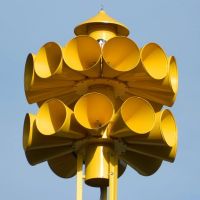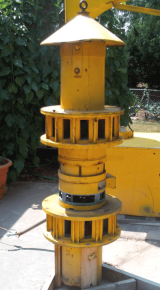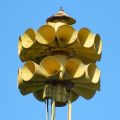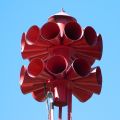XT22
| Model 2T22
Model 3T22 | |
 A Model 2T22A in Gray, GA. Photo taken by Christopher J. (TrainsAndSirens1). | |
| Company | |
|---|---|
| Produced | 1955-1992 |
| Type | Omnidirectional Electromechanical |
| Sound output | 113 dB @ 100 ft |
| Frequency | 50/60 Hz |
| Horsepower | 7.5-10 hp |
| Voltage | 208-240/480 V 1 or 3 ph |
| Preceded by | |
| Succeeded by | Federal Signal Model ECLIPSE |
| Documentation | Manual |
The Model 2T22 and Model 3T22[1] (2 or 3 Tone, 22 horns/ports) are a pair of dual rotor omnidirectional sirens that were produced by Federal Signal over a span of nearly 40 years. These are some of the most well-known and iconic sirens with a distinctive sound and are still commonly found today.
History
The Model 3T22 was first produced in 1955, at the dawn of the Cold War. Federal Signal lacked a siren with 3-signal capabilities that also met Federal Civil Defense requirements for a dual tone siren. Federal's existing dual tone sirens used a single rotor, which were not capable of creating a hi-lo signal. Federal decided to take inspiration from the dual rotor sirens that were used in the United Kingdom during World War II, but with enhanced performance through the use of horns and a more powerful 60 Hz motor.
From the beginning, the 3T22 was designed as a 3-signal siren, which could be used for civil defense and domestic use, particularly for fire departments and industrial zones. Later on, the 2-signal 2T22 would be released as an alternative to the 3T22, which was a cheaper alternative that lacked 3-signal capabilities. The 2T22 was fairly popular, though many places opted for the 3T22, even though most did not utilize the 3rd signal. Because of the increasing age of the design, as well as the lack of a need for dual tone sirens after the Cold War ended, the sirens were discontinued in 1992, with Federal Signal favoring production of the Model STH-10.
A well maintained 2T22 or 3T22 is a reliable and effective siren, which is why they are still a common find across the United States, being used as fire or severe weather sirens. While some have since been replaced by newer DC-operated sirens such as the ECLIPSE8, American Signal Corporation (ASC)'s Tempest-121, or rotational sirens, many cities have chosen to keep these aging beasts as with proper maintenance, these continue to be great sirens.
Design

The Model 2T22 and Model 3T22 are simple vertical dual rotor sirens, with 15-inch rotors/stators on each side of a dual shaft AC electric motor, with the top rotor being 12-port and the bottom rotor being 10-port. Each rotor has a long intake tube with mesh screens to prevent debris from getting inside, with the upper intake including a rain shield to keep moisture and debris from getting into the top rotor. Each port on the stator has a rounded horn of its own, similar to the Model STH-10 and Model STL-10. Due to being made of thin sheet metal, these horns are prone to warping and damage, and it is not uncommon to find these sirens with damaged or missing horns.
3 phase units (designated Model 2T22A and Model 3T22A on Federal Signal-era units) are powered by a bare dual sided 7.5 hp or 10 hp AC motor which was originally manufactured by Northwestern Electric for early FS&S models, and by Marathon for later models. Units with three phase Northwestern Electric motors are slightly shorter than units with Marathon motors. The sirens were also available in 1 ph (designated Model 2T22B and Model 3T22B on Federal Signal era units), using a 7.5 hp Northwestern Electric brushed motor. These are often lower pitched due to peaking at a lower RPM but are capable of reaching a higher pitch than 3 phase units if there is low enough air resistance due to the motor being non-synchronous (typically due to a blocked intake). These motors are physically taller than the other motors due to the additional space required for the brushes, making B models easy to differentiate from A models. This is not foolproof, however, as some three phase Northwestern Electric motors use the taller single phase shell.
The XT22 is able to reach 113 dB at 100 ft, which is respectable for a dual tone omnidirectional siren and outperformed most of Federal Signal's omnidirectional offerings at the time of its production.
3T22

The Model 3T22 is equipped with 2 solenoid-operated butterfly valve dampers, one in each intake. When the solenoids are energized, the dampers slam shut, restricting airflow to the chopper and greatly reducing its sound output. When the solenoid is de-energized, a return spring forces the damper back into the open position, allowing air to flow through again. When the two dampers alternate between open and closed while the siren is running, this creates a "hi-lo" signal. The dampers are also capable of operating in unison, creating a "pulse" signal. When the siren shuts off, both dampers automatically de-energize and open.
If the dampers are not maintained properly, the return spring can fail, causing the damper to be sucked shut when the siren activates which prevents the rotor from reaching its full volume. The solenoid mechanisms themselves can also become seized if they aren't maintained or used regularly. Because the dampers are very infrequently used nowadays, it can be very difficult to find a 3T22 that has both dampers working. Most fire departments who own 3T22s have ceased running the hi-lo signal for fire calls, instead running the attack signal instead.
2T22
The 2T22 lacks the dampers and solenoid mechanisms that the 3T22 has, which makes the siren lighter and cheaper to produce, but also renders it incapable of performing a 3rd signal. This can be a benefit, however, as the lack of dampers means the siren is less prone to intake clogs and requires far less maintenance. The 2T22 is entirely identical to the 3T22 with the exception of the dampers, and retains the extended intakes of the 3T22, likely as a cost saving measure. While both sirens are simple and require little maintenance, neither is without its issues. The cover on the top intake proved insufficient for keeping debris out, which often lead to these sirens having a blocked top intake, rendering the 12-port side near useless. This is especially the case for the 3T22, because the damper makes it even easier for the intakes to clog.
Gallery
-
A Model 2T22A in Hawkinsville, GA. Photo taken by Christopher J. (TrainsAndSirens1)
-
A Model 2T22B in Boiling Springs, NC. Photo taken by Christopher J. (TrainsAndSirens1)
References
- ↑ "XT22" is not the name of the sirens, rather a way of describing both models at once for brevity. It is also a commonly used name when one is unsure whether a unit is a Model 2T22 or Model 3T22. The XT22 name was created by enthusiasts and not used by Federal Signal.

